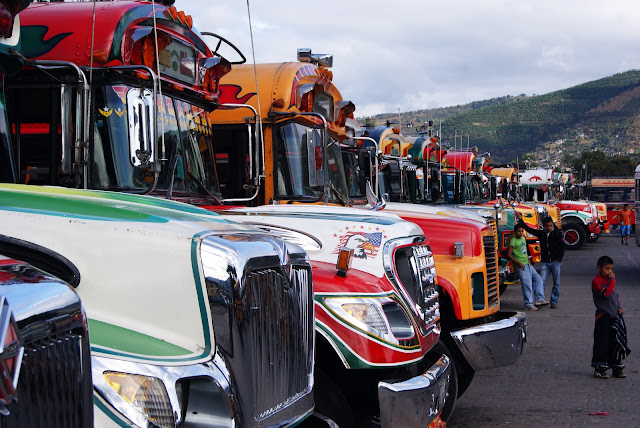
Have you ever wondered what happens to those big yellow
school buses once they’re replaced with newer models? I didn’t think so.
Neither have I.
Once retired, school buses are (apparently) sent down to
Central America, where they live out the rest of their days as local public
transportation. After being given a flashy new paint job and covered in various
Spanish versions of ‘I heart Jesus’. Obviously.
The old Bluebird buses, nicknamed chicken buses for the
sheer multitude and variety of things that fill aisles and overhead racks (I
hear that crates of chickens are common, but have only seen chickens
transported in squirming, noisy bags), often still have the rules to keep
school children in line posted up front. It is a bit strange to look around at
the familiar interior of a school bus, such a time lurch, and have it be so out
of place in another country. And so full of its citizens.
And I mean full. Seats originally designed to hold two
children are packed with three grown adults, and typically a child or two,
while others stand in the aisle. Personal space is not a concept that seems to
exist here. Children sprawl into your lap, babies drool on your arm, grown men
fall asleep on your shoulder, all while the bus careens through mountain
passes.
We have come to love the chicken bus. Not only does it cost
far less than taking the nicer tourist buses, it also…okay, that might be its
main draw. Yep, we love the price.
In fact, we love it so much, we took a chicken bus from
Nicaragua to Guatemala. Three borders,
four countries, and seventeen hours. But to be fair, it was supposed to be over
25 hours; they drive their buses a bit differently down here. Even with only
two people per seat, that is still a long time on a school bus. Especially when
you’re in the back and cargo -- including a wheelchair, a walker, and a
bedframe -- fills the aisle to the ceiling.
Despite the lack of comfort and space, there always seems to
be a general sense of accommodation, courtesy, and good humor. Even as the only
gringos (we have yet to see any other foreigners on a chicken bus), we receive
helping hands and big toothy grins all the way to our destination. No matter
how many buses it takes us to get there.














